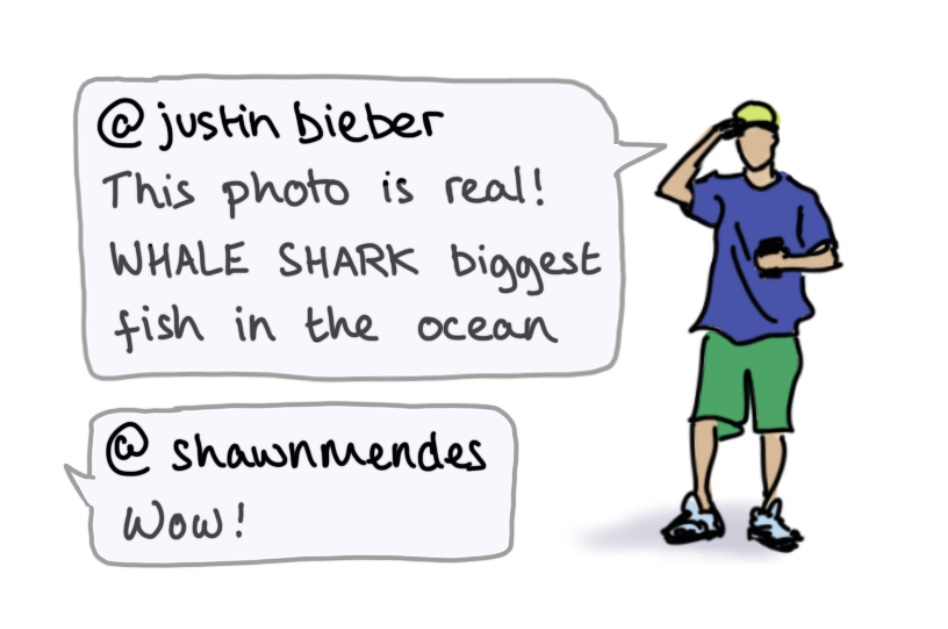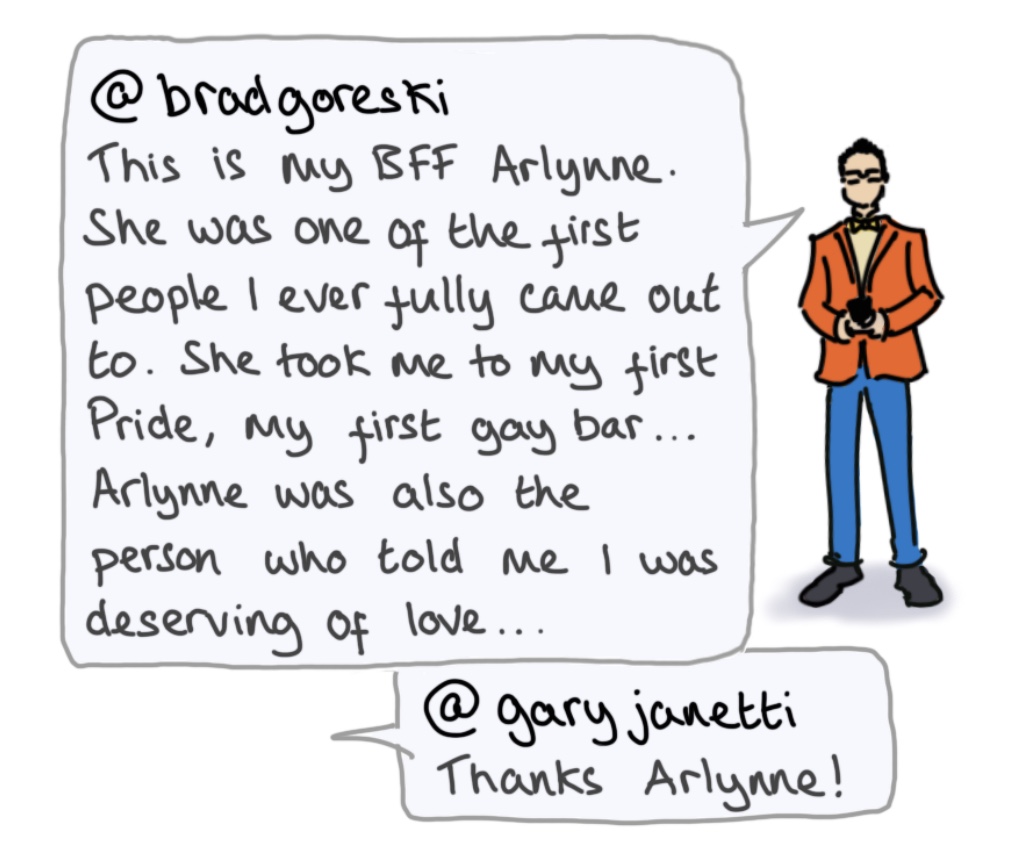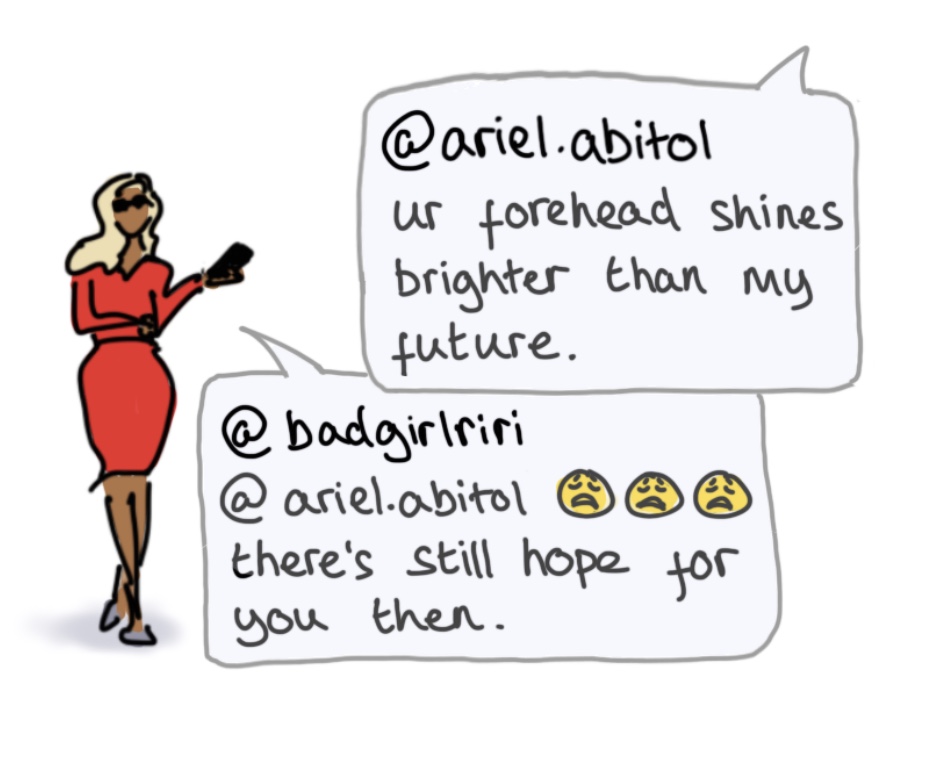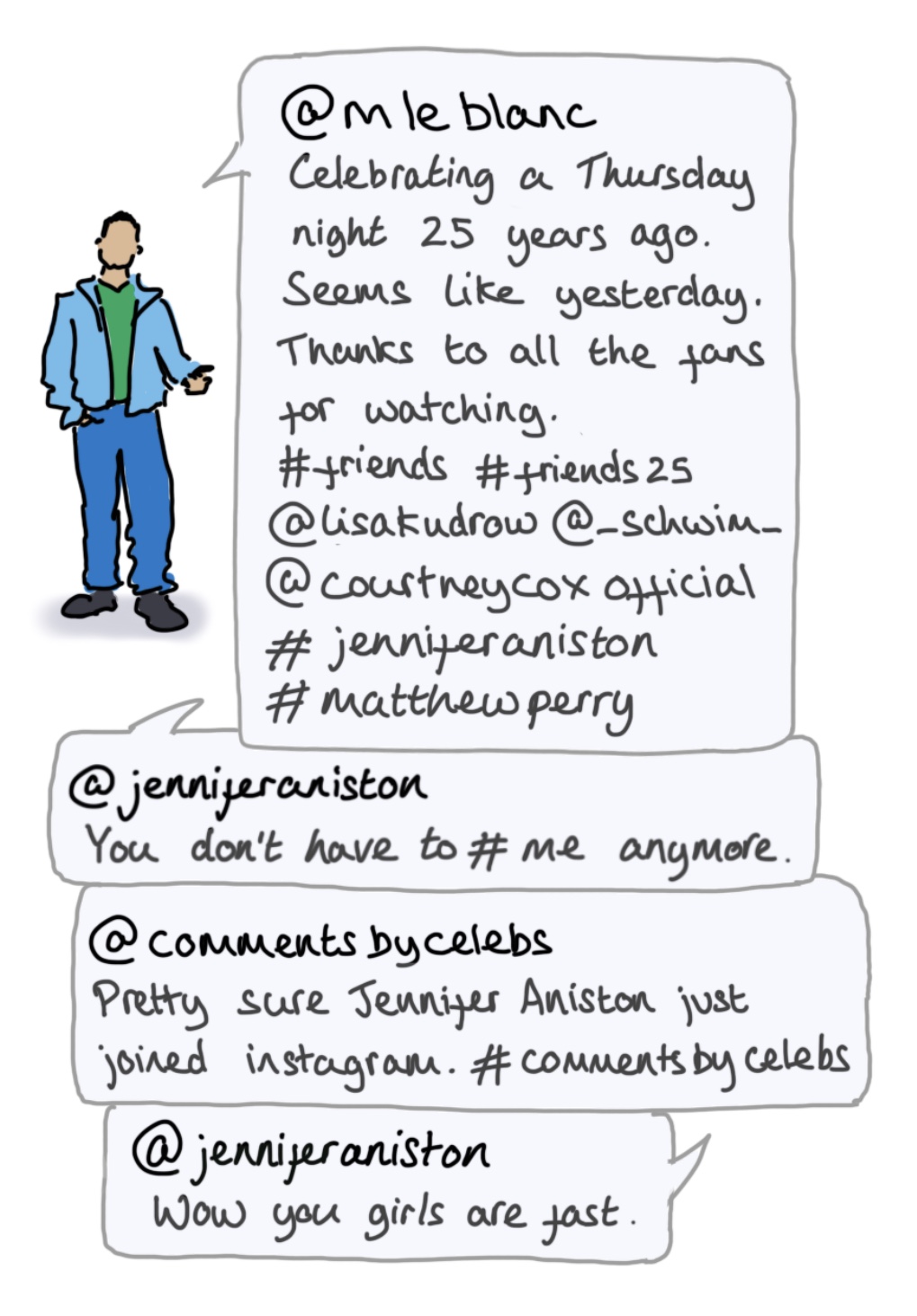Article begins
How an Instagram-based gossip franchise allows celebrities to manage the authenticity of their public personae.
They go to the market! They pump gas! They explore the park! One of the most familiar genres of celebrity gossip reporting is the “they’re just like us!” narrative. If you’ve ever flipped through a copy of Us Weekly in the checkout line at the store, you’ve probably come across it. Paparazzi photographs of Diana Ross pushing a cart full of grocery bags, Sylvester Stallone browsing confectionary at candy store, and Heidi Klum on a coffee run turn the extraordinary figure of the superstar into something more quotidian and familiar. Our fascination with this sort of transformation reveals a crucial facet of the celebrity gossip industry: mundane, everyday practices make celebrities appear authentic in a way that resonates with the public.

Image description: Cartoon illustration of singer, songwriter, and actor Justin Bieber. Text from Bieber’s Instagram account appears in speech bubbles and reads as follows: “@justin bieber This photo is real! WHALE SHARK biggest fish in the ocean.” “@shawnmendes Wow!” Charlotte Hollands
As celebrities increasingly rely on social media platforms to do the work of promoting their personal brands and controlling gossip about themselves, language has become an indispensable tool. Not that it wasn’t before—red carpet interviews, statements by publicists, and information leaked “from a source close to the star” all involve the skillful shaping of language to reflect a particular celebrity persona. Yet, there is a pervasive sense that interaction on social media is especially informal, casual, and off-the-cuff, that social media communication is mundane and therefore authentic.
Yet, in order to use social media for the work of personal branding and persona management, celebrities must also distinguish their accounts and posts as legitimate. This allows them to stand out from myriad fan and gossip accounts that use celebrity names in their account titles to offer unauthorized reporting. Platforms such as Facebook, Twitter, and Instagram attach a blue check next to celebrity account names to indicate that they have “verified” the account—that is, determined it is owned and operated by that particular individual. However, the semiotic legitimation provided by the blue check can sometimes negate the sense of mundane authenticity that the casual style of social media posts is meant to inspire. In her study of celebrity sightings, sociologist Kerry Ferris describes this tension as a “juxtaposition of ordinary and extraordinary frames of meaning” (2004, 237), whereby too much “extraordinariness” in an “ordinary” frame can cause the public to see a celebrity as out-of-touch, snobbish, and elitist. One way celebrities manage such tensions between ordinary and extraordinary frames of meaning is through their careful engagement with social media gossip accounts.

Image description: Cartoon illustration of fashion stylist and television personality Brad Goreski. Text from Goreski’s Instagram account appears in speech bubbles and reads as follows: “@bradgoreski This is my BFF Arlynne. She was one of the first people I ever fully came out to. She took me to my first Pride, my first gay bar… Arlynne was also the person who told me I was deserving of love…” “@gary janetti Thanks Arlynne!” Charlotte Hollands
In early 2017, Instagram introduced an algorithm that prioritized comments from verified accounts. Rather than showing a chronologically ordered list of every “OMG!” and “love this!” on a post, comments from accounts that had earned the iconic blue check were now prominently displayed near the top of the comments section on any given post. Two avid Instagrammers and pop-culture enthusiasts, Emma Diamond and Julie Kramer, noticed that this algorithmic alteration served to highlight the latest social media activity of their favorite celebrities. They soon founded their own Instagram account, Comments by Celebs (CBC), which screenshots and curates celebrity comments from across the platform. The two media professionals have since expanded their franchise to include several related accounts, such as Comments by Athletes (self-explanatory) and Comments by Bachelor (comments from stars of the Bachelor/Bachelorette reality television franchise) as well as a podcast in which they discuss how the comments celebrities post on social media “translates into real life drama.”
In a certain sense, CBC is a celebrity gossip-based social media account focused primarily on what celebrities say rather than what they do. It’s a truism in linguistic anthropology that saying is a kind of doing—but these social media posts highlight linguistic skill in a way that Us Weekly‘s “Stars—They’re Just Like Us” column does not and cannot. Like unstaged paparazzi shots, Instagram posts often show celebrities at home with their families, in casual clothing, and sometimes even without makeup. Yet, these Instagram posts come coupled with the celebrity’s name and the blue check mark of authenticity, corroborating that they come straight from the source (rather than a photographer hiding in the bushes). Captions for Us Weekly paparazzi photographs lean toward a sensationalist yet stilted style, while Instagram captions are meant to be read in the celebrity’s own voice, complete with typos, emojis, and other markers of casual language use. In combining the informal visual aesthetics of personal photographs with casual (but verified) comments in their own words, celebrities add linguistic resources to their visual performance of doing mundanity and ordinariness.

Image description: Cartoon illustration of climate activist Greta Thunberg. Text from Thunberg’s Instagram account appears in speech bubbles and reads as follows: “@greatthunberg Canada! See you tomorrow at the strike! #climatestrike #fridaysforfuture.” “@chelseahandler You make me want to have kids, but I won’t.” Charlotte Hollands
These two forms of semiotic authenticity—the mundane and the legitimate—are central concerns in linguistic anthropology, which considers how all semiotic resources (including, but not limited to language) are used in the construction of public personae (see Nakassis 2016 for a robust discussion of how linguistic anthropology is about more than language). Mary Bucholtz describes linguistic mundaneness as one of the pervading ideologies in linguistic anthropology and sociolinguistics about what constitutes “authentic” language. Mundane language is “language that, from its user’s point of view, is unremarkable, commonplace, everyday” (2003, 405). We can think about this mundane authenticity in terms of visual aesthetics and other forms of semiosis. For instance, the sense of mundanity in seeing a celebrity carrying grocery bags through a parking lot or at a gas station filling up their car, or reading a celebrity’s utterly vapid “wow!” in response to a viral social media post. Angela Reyes (2017) has highlighted how authenticity is often posited as a distinction between “real” objects and “fakes.” In the case of celebrity gossip, we determine real (authentic) celebrity accounts by the blue check mark of verification, and assume accounts that bear a celebrity’s name without the blue check are fake (inauthentic).
The CBC celebrity gossip franchise works by drawing attention to celebrity social media posts that skillfully blend these two forms of semiotic authenticity. Although celebrity gossip industry mainstays such as “Stars—They’re Just Like Us” are also framed as portraits of mundane authenticity, gossip seekers on the CBC Instagram feed are also able to experience a heightened sense of closeness and familiarity with the real stars and their legitimately authentic “voice.”
The kind of celebrity comments that CBC features run the gamut from dramatic clapbacks (Rihanna checking a retort about a photograph showing her shiny forehead) to heartwarming reflections (Brad Goreski thanking his best friend for her support with a photograph of the pair as teenagers) to political commentary (Chelsea Handler commenting on Greta Thunberg’s post about the Montreal climate march). It’s easy to see why CBC showcases these kinds of showbiz posts and comments—many of them are funny or provoke emotional reactions. Yet, a large part of CBC’s reporting strategy relies not only on celebrity posts, but on celebrity exchanges.

Image description: Cartoon illustration of singer, songwriter, and actor Rihanna. Text from Rihanna’s Instagram account appears in speech bubbles and reads as follows: “@ariel.abitol ur forehead shines brighter than my future.” “@badgirlriri @ariel.arbitol [sigh emoji, sigh emoji, sigh emoji] there’s still hope for you then.” Charlotte Hollands
What is notable or exciting about Sean Mendes replying “wow!” to Justin Bieber’s post about a photograph of a whale shark? Well… nothing. But, in a celebrity gossip economy in which mundane authenticity is an important currency, this kind of exchange is precisely what Diamond and Kramer look for. As the CBC tagline goes, “even famous people love famous people.” In an interview with Buzzfeed, Kramer describes social media as a way for the gossip industry to increase its access to celebrities, “…a lot of celebrities’ relevancy is dependent on social media. I think we will continue to see a trend of celebrities who were previously ’untouchable’ divulging different aspects of their lives via social media so that they can remain relevant, as well as connect with their fans.” In my work on how the singer Lady Gaga cultivates an “authentic” celebrity persona in interactions with her fans, I found that the star nurtures a sense of intimacy or relational closeness through pointing to shared sensations of mundanity—going to the same bars as her fans, divulging personal struggles, or shopping for her own CDs at WalMart (Valentinsson 2018). Such performances of mundanity were clearly part of a calculated branding strategy, designed to make her fans feel personally invested in her success and thus commit to supporting her work. Observing the way celebrities write comments designed to catch the attention of Kramer and Diamond as well as how celebrities actively engage with the franchise shows how social media gossip accounts have become a new venue for celebrities to do the work of balancing mundane authenticity with legitimate authenticity.
As the CBC brand has grown, much of their reporting has come to focus on and promote how celebrities engage with the CBC account. When famously social media-averse film and television star (and frequent subject of celebrity gossip pages) Jennifer Aniston joined Instagram, CBC was one of the first outlets to report on the news—even before Aniston’s account had been officially verified. Aniston replied to CBC’s post directly, with a pithy “Wow you girls are fast.”

Image description: Cartoon illustration of actor Matt LeBlanc. Text from LeBlanc’s Instagram account appears in speech bubbles and reads as follows: “@m le blanc Celebrating a Thursday night 25 years ago. Seems like yesterday. Thanks to all the fans for watching. #friends #friends25 @LisaKudrow @_schwim_ @courtneycoxofficial #jenniferanistron #matthewperry.” “@jenniferaniston You don’t have to # me anymore.” “@commentsbycelebs Pretty sure Jennifer Aniston just joined Instagram. #commentsbycelebs” “@jenniferaniston Wow you girls are fast.” Charlotte Hollands
Many other celebrities respond to CBC posts and reports with their own comment or riposte, and several have appeared on Diamond and Kramer’s podcast. Kelly Ripa, host of the syndicated morning talk show Live with Kelly and Ryan and a celebrity in her own right, helped catapult the CBC brand to a wider audience when she mentioned them on her show. Soon after, Ripa appeared on the first episode of their podcast. Over 100 episodes later, the CBC podcast has featured actor Jerry O’Connell, actor and reality star Lisa Rinna, and, most recently, singer-songwriter John Mayer. In Mayer’s episode, the star argued that the celebrity interest in CBC is based on “a natural human instinct to get your attention.” Similarly, in a Vanity Fair profile on CBC, Diamond suggested that the platform’s popularity with celebrities is due to “an aspect to it that’s just general human nature, which is people want people to think they’re funny […] [Y]ou think these celebrities are so famous, but yet they still like that basic human gratification.” These appeals to “natural” or “basic” human instincts are, of course, ways of discursively producing mundane authenticity. Unlike Us Weekly paparazzi shots, CBC offers celebrities a space to engage in these performances in a way that is legitimately authentic—designed and initiated by the celebrities themselves. As Vanity Fair noted, “[o]ne of the unexpected consequences of the account’s popularity is that several celebrities have reached out to the pair, and get very excited when they see themselves featured […] Getting highlighted on Comments by Celebs is an emerging form of ‘promotion’ for stars.”
Although the celebrity posts and comments that appear on CBC are written in an ordinary style that hallmarks a mundane authenticity, these linguistic performances are designed to be featured as special and extraordinary, as the little blue checks of legitimate authenticity render them suitable CBC material. Thus, as familiar and informal as a celebrity’s social media presence may feel, it is a carefully crafted form of personal brand and gossip management.
Mary-Caitlyn Valentinsson earned her doctorate in 2019 and is currently a visiting assistant professor in the Department of Anthropology at Appalachian State University. Her work focuses on digital media, pop culture, and the social circulation of language. Find more of her work at mcvalentinsson.com or on Twitter @DrMCV.
Charlotte Hollands is an illustrator, artist, and ethnographer who is fascinated with the power of hand-drawn images to reveal and describe complex truths. She is developing new ways to use illustration within social science research and is currently completing her first graphic non-fiction book, written by Alisse Waterston.
Cite as: Valentinsson, Mary-Caitlyn. 2020. “Stars—They Talk Just Like Us!” Anthropology News website, February 20, 2020. DOI: 10.1111/AN.1354

